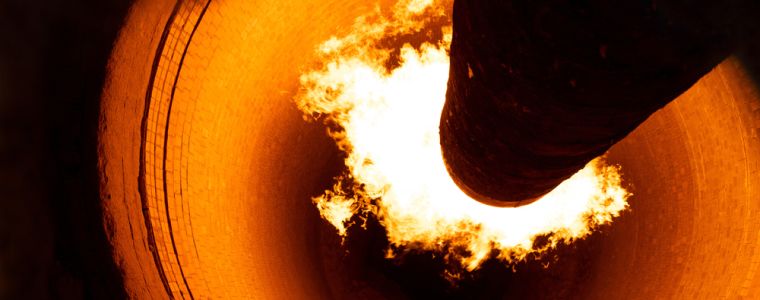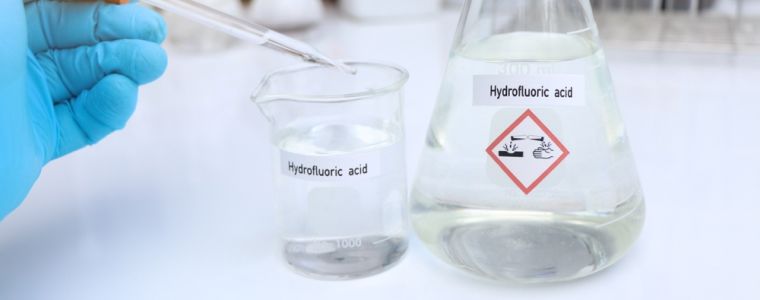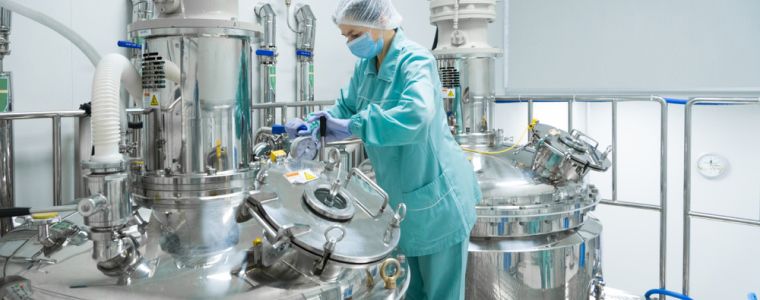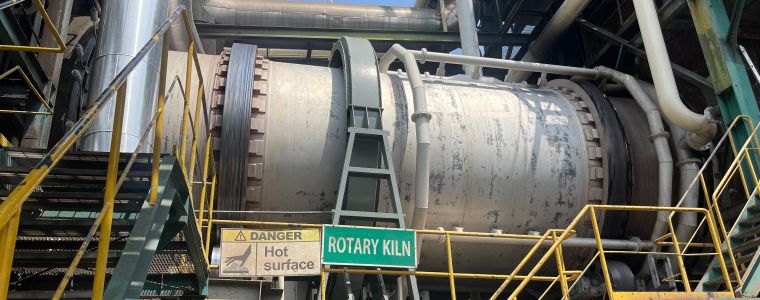Rotary Kilns used in the Manufacture of Hydrofluoric Acid (HF)

Hydrofluoric acid (HF) is widely used as a precursor to most fluorine compounds such as pickling solutions, fluorocarbons (TFE and FEP in Teflon) and fluoxetine (Prozac) etc. Solutions of HF are colourless, acidic and highly corrosive. HF solution is extremely corrosive towards most alloys, gold, silver and even platinum. It is usually stored and handled using plastic or a few specific grades of alloys when it comes to structural applications.
Rotary kilns play a vital role in the manufacturing process of Hydrofluoric Acid (HF), providing a controlled environment for crucial chemical reactions.
What is a Rotary Kiln?
A rotary kiln is an advanced thermal processing cylinder, rotating around its cylindrical axis. It is used to process solid materials at extremely high temperatures to cause a chemical reaction or physical change. An inclination on the horizontal axis moves the material being processed from the feed line to the discharge head. Factors affecting successful operations are the temperature, rotation speed, angle of incline-material flow, and discharge rate. Internal fins can help mix and tumble the material.
How is a Rotary Kiln Used in the Manufacturing Process?

Rotary kilns serve as indispensable equipment in the manufacture of Hydrofluoric Acid, providing the necessary heat, mixing, and control to facilitate efficient chemical reactions and produce high-quality HF products. Here is how rotary kilns are utilised in the production of HF:
- Raw Material Preparation: The process begins with the preparation of raw materials, primarily fluorspar (calcium fluoride), which is mined and processed to remove impurities. The fluorspar is then fed into the rotary kiln along with sulphuric acid, the other key ingredient in HF production.
- Chemical Reaction: Inside the rotary kiln, fluorspar reacts with sulphuric acid in a carefully controlled exothermic reaction. This reaction produces hydrogen fluoride gas (HF) and calcium sulphate (CaSO4) as by-products. The rotary kiln provides the necessary heat and mixing to facilitate the reaction, ensuring optimal conversion of fluorspar into HF.
- Hydrogen Fluoride Recovery: The hydrogen fluoride gas generated in the rotary kiln is then cooled and condensed to form a concentrated solution of HF. This solution undergoes further purification steps to remove impurities and adjust its concentration as needed for specific applications.
- Temperature and Atmosphere Control: Rotary kilns offer precise control over temperature and atmosphere, critical factors in HF production. The temperature must be maintained within a certain range to ensure efficient reaction kinetics, while the atmosphere inside the kiln is carefully controlled to prevent unwanted side reactions and ensure the purity of the HF product.
- Safety Considerations: Safety is paramount in the manufacture of HF due to its highly corrosive and toxic nature. Proper ventilation, containment systems, and personal protective equipment are essential to minimise the risk of exposure to HF vapours and ensure the safety of workers and the surrounding environment.
The versatility and reliability of rotary kilns make them invaluable assets in the HF production process, contributing to the advancement of various industrial and technological applications.
The Manufacturing Process of Hydrofluoric Acid

The manufacturing process of hydrofluoric acid involves two stages.
- In the first stage, the starting product, fluorspar (Calcium fluoride), is heated and mixed with heated sulphuric acid in a rotary kiln. This exothermic reaction can reach temperatures up to 150°C.
- The second stage, also conducted in a rotary kiln, produces hydrogen fluoride gas. The gas is then either liquefied or diluted with water to produce a hydrofluoric acid solution.
It’s important to note that both hydrogen fluoride fumes and sulphuric acid are highly corrosive and pose a danger to life.
Hydrofluoric Acid Uses

Hydrofluoric acid is a versatile chemical with diverse applications across industries. Hydrofluoric acid uses are as follows:
1. Chemical Manufacturing: It’s crucial for producing fluorocarbons, fluorinated polymers, and etching silicon wafers in semiconductor manufacturing.
2. Metal Processing: Used for cleaning metals like stainless steel and aluminium, and preparing surfaces for further processing.
3. Petroleum Refining: Essential in alkylation processes for high-octane gasoline production.
4. Glass Etching: Employed in the glass industry for decorative etching on glassware and architectural glass.
5. Laboratory Research: Utilised for sample preparation and synthesis in analytical chemistry.
6. Dental and Medical Applications: Used in dentistry for etching dental ceramics and occasionally in medical treatments.
7. Hydrogen Fluoride Production: Acts as a precursor in the production of hydrogen fluoride for various industrial processes.
Despite its utility, handling hydrofluoric acid requires strict safety measures due to its reactivity and toxicity.
Alloy Selection
The alloys used must be able to resist hot concentrated sulphuric acid as well as hydrofluoric acid and possess adequate erosion resistance to fluorspar and calcium sulphate crystals.
Alloy C276 sheet is a popular choice for lining the rotary kiln to protect it from dissolving.
Alloy 22 is used as a weld overlay on carbon steels, low alloy steels and stainless steels. (25%-50% HF concentration at 30°C-80°C).
Alloy 400 if used, it must be borne in mind that stress–corrosion cracking can occur in hydrofluoric acid vapours containing air and to a lesser extent also in the liquid phase.
Useful links:
Let NeoNickel assist you in choosing the correct nickel alloy for your application. Contact us for technical support, sales enquiries, and more.

